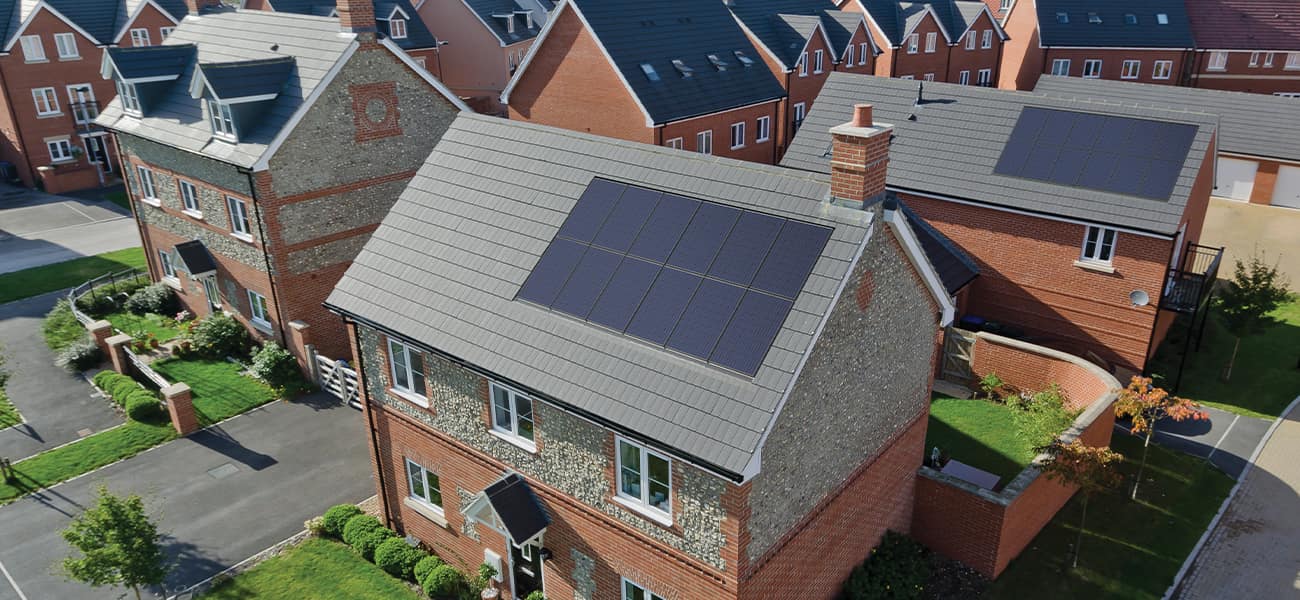Why build-to-rent developers should incorporate solar roof tiles, solar batteries and inverters into future projects

Fitting Build-to-Rent properties with solar roof tiles, a solar inverter and solar battery storage can improve their green credentials and reduce running costs by capturing and storing renewable, clean energy from the sun. Along with this a greater awareness of sustainability and ‘greener’ living has led to an increase in people looking for homes that include energy saving products such as solar roof tiles, solar batteries and solar inverters.
A survey conducted by YouGov, on behalf of Legal & General, showed that private renters are willing to pay up to 13% more rent for a low-carbon, energy-efficient property (1) . Adding solar technology to Build-to-Rent properties can increase their appeal for several reasons, including:
- Commanding a higher rental price
- Helping tenants reduce their electricity bills
- Lessening the impact of energy price increases
- Reducing a property’s impact on the environment by using renewable, clean energy
- Providing back-up electricity in the event of a power cut
- Improving a building’s EPC (energy performance certificate) rating
How solar roof tiles, solar batteries and inverters can improve a property’s appeal
By using clean, renewable solar energy for power and heat, a home’s impact on the environment and its ‘carbon footprint’ can be substantially reduced whilst also lowering running costs and reliance on grid electricity. Adding solar capture and energy storage offers support to existing tenants as well as increasing the property’s appeal to the rental market.
Does installing solar roof tiles, solar batteries and inverters affect an energy performance certificate (EPC) rating?
Landlords are required by law to provide tenants with a current copy of the property’s EPC (energy performance certificate). Installing solar, (also known as photovoltaic or ‘PV’ for short) electricity generation is classed as an ‘energy efficiency measure’ and will improve the building’s EPC rating, increasing it by between 10 and 15 points (2).
Increasing awareness of greener living
As more people become aware of environmental issues, interest in renewable, clean energy and sustainable living is increasing. Research indicates that online searches for solar panel installations increased 32.85 percent from 2022-2023. The high demand means that fitting properties with solar electricity generation and storage has become a smart investment for landlords. As well as offering financial benefits, energy enhancements help lower carbon emissions and contribute to a greener, more sustainable future.
Using solar roof tiles
Conventional solar panels are fitted above the roof tiles leaving a void below which can cause issues due to nesting birds and gutter blockages. This could cause the landlord additional maintenance costs but could also impact the peacefulness of the tenant’s property. A new Build-to-Rent property’s roof can benefit from the inclusion of integrated solar roof tiles such as the Marley SolarTile®. These use the same PV technology as solar panels to convert sunlight into electricity and provide an almost maintenance free solution., The Marley SolarTile® is integrated into the roof structure, where it forms part of the finish and weather protection layer, giving the roof a better aesthetic, improving its overall visual appeal and preventing birds nesting beneath the panels.
Making the most of solar roof tiles, solar batteries and inverters
During the daytime when the energy demands of a property tend to be lower, a renewable energy system (consisting of solar roof tiles, solar batteries and inverters) can generate more electricity than the home requires. Adding a solar battery enables the system to store this ‘excess’ electricity which it can then make available when the occupant’s needs increase and electricity from the grid is at its most costly.
As well as storing excess electricity produced by the PV system, a solar battery can be used to provide power during a power outage. A typical solar battery storage system can supply a property with electricity in the event of a power cut.
Solar roof tiles do not produce electricity during darkness; however it is possible to charge a solar battery using off-peak electricity supplied at a lower cost by the grid. This stored electricity can then be used the next day to help power the home in the normal way. Using a solar battery in this way maximises the benefit of a renewable energy system. This is a particular advantage during the winter months when less solar energy is available.
The solar inverter
Solar roof tiles and PV panels convert sunlight into direct current (DC) electricity, in order to be used by the household, this must be converted to alternating current (AC) using an inverter. The inverter and its electronics form the brains of the renewable energy system and are used to regulate and control the supply of power to the home. A renewable energy system featuring back-up supply uses the inverter to rapidly switch the electricity supply from the grid to the solar battery in the event of a power cut.
Marley SolarTile® and battery storage systems
Marley can supply the individual products needed to capture and store solar energy as well as a full system which incorporates Marley SolarTile® roof tiles, the inverter unit, storage batteries and an electric vehicle charger. The components of a complete Marley renewable energy system are tested and matched to ensure full compatibility so you can be sure the system is designed and built to help you make the most of renewable, clean energy.
You can learn more here about Marley’s renewable energy system range including our Marley SolarTile®, solar inverter, solar storage battery and EV charger.
If you would like to discuss using our solar roof tiles and storage battery solutions on your next development, please contact us here.
(1) https://group.legalandgeneral.com/en/newsroom/press-releases/legal-general-research-shows-buyers-will-pay-up-to-20-premium-for-low-carbon-homes
(2) https://thecertificatelab.co.uk/how-to-improve-your-epc-rating-with-solar-panels/
Category: Solar Sustainability